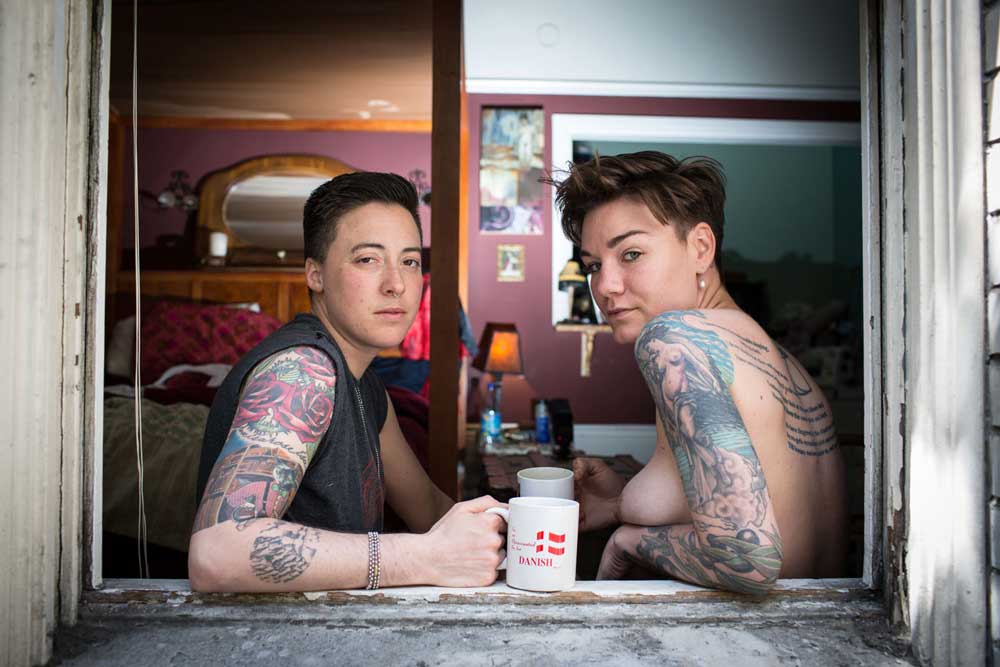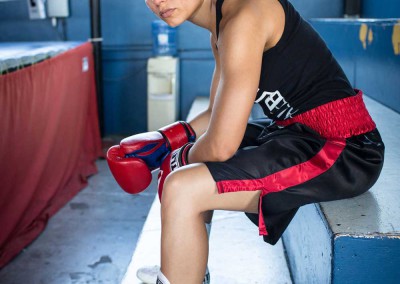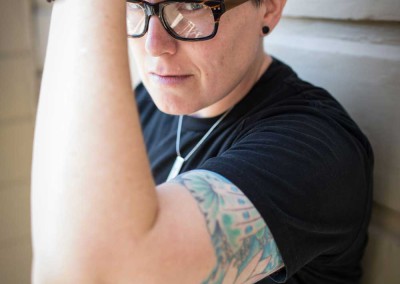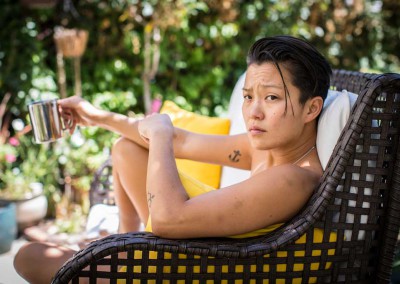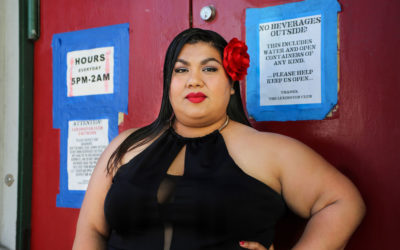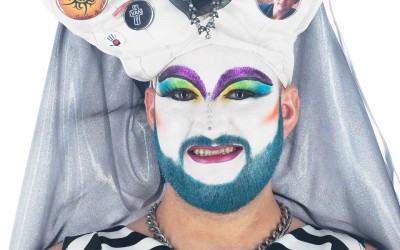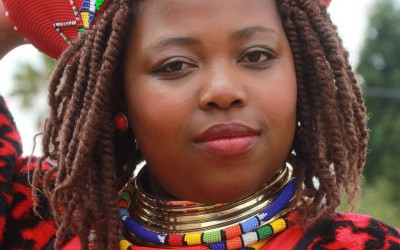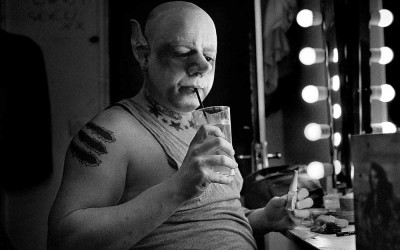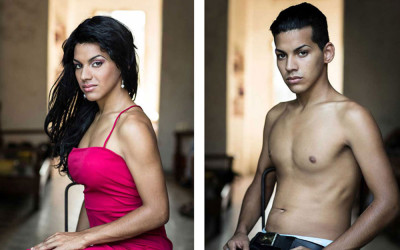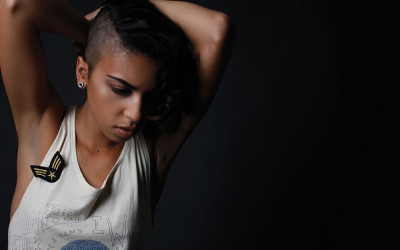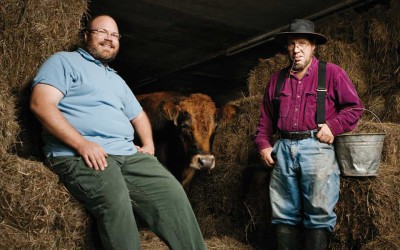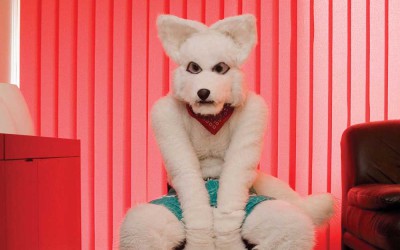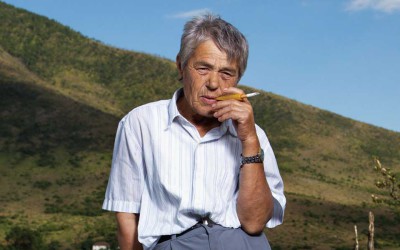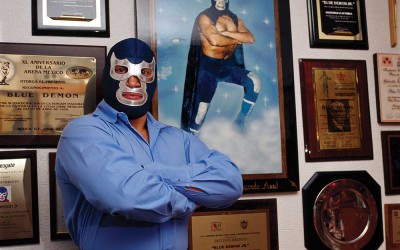Meg Allen
Text JF. Pierets Photos Meg Allen
In her series ‘Butch’, photographer Meg Allen shows a variety of women who fall under the category of more masculine than feminine. Over the years people have been given different names to lesbians, and being butch is yet another flavor of women. Another flavor of lesbian, which Allen captures in a very intense and fierce image. Her women are beautiful, strong and aren’t afraid to show their true colors. Honest, might be another way of putting it.
What’s in a name?
Nothing really. The series was something I almost didn’t want to define. It isn’t a stereotypical thing and it isn’t just about short hair, or swagger, or a tomboy. For me butch means ‘on the masculine side’. That’s it really. Nothing more and nothing less. Just another categorization that can share definition with any other term within the umbrella of masculinity. It’s what gender ends up being when you try to define it; an exaggerated version of itself.
You like to let your pictures speak for themselves?
Exactly. I’m still exploring who I am as a photographer and an artist. This series is a chance to work within the queer community in a different way. And honestly, in the beginning it was just me, practicing my photography. Because I wanted to do portraits for professionals, I started asking my friends if they could sit for me. Yet the more people I photographed, the more I realized that I was capturing something I hadn’t seen before in art galleries or magazines. I put them up on my wall starting with 3 photographs, then 10, then 15. And all of a sudden I wanted to fill the whole room. Just to see what it felt like to look at a bunch of people who looked like me. Putting them together so concentrated, made me want to show the uniqueness of butch women in a way that glamorizes them in their natural habitat. The women aren’t mainstream yet their life could be anybody’s.
Is gender a fashionable thing?
I think people do wear gender like they wear fashion. For the most part everybody is somewhere in between both of those things. When you for example dress up for the opera or the ballet, you become this sophisticated, cultured, wealthy seeming thing. And that’s not just who you are, but it’s who you are in that moment. It’s so frivolous yet so important because people dress up every day. Some people say they don’t care but that’s also a statement. It’s part of their philosophy. I never wanted to wear dresses and that was a choice because I didn’t felt like I was a person who wears dresses. I was more adventurous. I felt handsome rather than pretty and strong versus coy. When you dress yourself, you’re making a statement. So I think it lies somewhere in there, constantly shifting and fluid.
Is it a sign of the times? That gender is getting more fluid?
Absolutely! I think it has been influenced by a lot of equality movements between the sexes and even between races. There is no hierarchy of human, where women are second rate to men. But ask anybody and they will give you their own definition of what it means to be male vs. female. Gender is such a complex thing. On one hand you have a description of your sex, your genitals, but attributes of masculine and feminine are something different. Gender becomes the more complicated version of whether you are man or woman. Americans have this exaggerated form of male and female. The men are hyper-masculine, rugged, handsome, strong and aren’t encouraged to cry. Yet in many parts of Europe, men are allowed to be who they are, rather than forced in a stereotype of what a man should be. I have a friend who is from Denmark and she was saying that they don’t have a word for butch, because gender isn’t strictly masculine males and feminine female. I thought that was both interesting and difficult to imagine. That there is no need to have this strict definition because gender actually isn’t polarized. I need to add that I’ve never been there, so I have to take her word for it.
You take photographs of your friends. You have a lot of friends…
Well, it’s a big community here. I would say the first 30 people are definitely friends and people I’ve known over the years. Then when I had a show at the Lexington club in San Francisco, the series really sort of took off and a lot of people contacted me to be part of the project. There’s a big scene in San Francisco and the community here is huge. You really have to come over, it will blow your mind.
How does it feel to be gay in San Francisco?
Being gay in San Francisco hasn’t been a big deal since the 80’s, we’re super lucky to live in such a mecca. The straight people aren’t as phased by sexuality in San Francisco. People in San Francisco are more liberal about just about everything. As a country, we’re still behind on gay marriage but it’s going to the Supreme Court and they are about to make a ruling for it to be federally recognized across the US. So as far as the gay movement is concerned federally, things are changing quite a bit. That said, I feel very lucky to be born a gay person in a straight privileged world. I feel it gives us license to look differently at tradition and the way society wants you to be. It allows us to reinvent ourselves constantly, because there is no set path that we have to follow. Do we decide to marry? Do we duck the trends of fashion so we can feel more who we are and how we want to be seen in the world? I think most straight people don’t have that luxury. They are sort of guided along, ushered in to well-worn and accepted paths. Later on in life they might be disappointed because they didn’t realize there was so much more to choose from. Being gay pushes you out of certain traditions and suddenly reveals that the world is actually bigger than your own community’s traditions and is this crazy amazing place to explore. There are so many traditions that you can adopt from. So many other cultures and countries that can make you happy. When you are gay you are not just trudging along blindly, following the person in front of you, just because that’s what you’re supposed to do. You invent yourself by making your own choices.
You’re still exploring who you are as a photographer. Is there a change you’re going to specialize in queer subjects?
The fact that I’m gay and very alternative, gender wise will always influence my work. I won’t necessarily specialize in it but it will always be present in my work. I do love this theme though, and I love to make queer culture visible. One of the most amazing things people told me after seeing my ‘Butch’ series, was this straight guy who said he loved watching my pictures, because he never had the chance to really look. He always felt uncomfortable about staring at people who looked different and this gave him the opportunity to just stare and take it all in. That’s what I love most about art. It has the capacity to take you on this journey and tell you a story about something you wouldn’t have seen otherwise. You’re able to loose yourself, as you’re looking at these other people, identifying with them and recognizing differences. There is this universal feeling of the human condition and that’s the part that I aim for; combining differences with familiarity, and making it not such a rigid rectilinear definition.
‘I feel very lucky to be born a gay person in a straight privileged world. I feel it gives us license to look differently at tradition and the way society wants you to be. It allows us to reinvent ourselves constantly, because there is no set path that we have to follow.’
You also consider it a time document.
A lot of people responded to these portraits, a lot of people felt seen and it’s a record in time about butch women feeling safe enough to do this. To let people look at them. There used to be a lot of violence against butch women, and the gay community in general, in the past and actually still to this day. Butches would get harassed a lot and therefor didn’t want any attention put on them. They didn’t want to be seen and just tried to blend into the world of masculinity and live their lives. The first people I asked to sit for me were really unsure but after they saw what I was doing, they could see that it was bigger than themselves. That I would make them feel comfortable and illuminate them in the proper light. I think it was the right time to make this series.
This project has gotten a lot of attention, what’s next?
My next project is shooting portraits of transgender FTMs. Interesting thing is, that some people I’ve shot for ‘Butch’, also want to sit for this next one. I love that. It means they define themselves in multiple ways. Needless to say it’s going to be a completely different type of project and portraits, but I like the multiple identity factor. Definitions and stereotypes lose their power when you really try to nail it down so I aim to nuance my photographs. You can see that butch is not only about masculinity. It’s not because you are butch that you can’t be soft or fashionable.
I read somewhere that you want to make a book when you are at 117 portraits. What’s with the number?
I was very influenced by Annie Leibovitz as a young photographer. She did a lot of photographs for Vanity Fair and I love the way that is able to capture people. I admire that she could almost get into somebodies soul and bring it out in a picture. That’s an amazing thing to do. I think that’s also what I like about being a photographer. I’m not very good at bullshitting. Going to a bar and chitchatting just isn’t my thing. I’m not funny, so that doesn’t help either. Even on the first casual introduction I get right into it and ask people what their life is all about, what they love and what bothers them. Sometimes that’s awkward when you are meeting someone for the first time. A bit too intense maybe, but when you are photographing somebody and they are willing to open themselves up to that, you sort of get to go on this journey together and go deeper than any other random contact. You get intimate in this very artistic way. You’re both human and into this together. Leibovitz did that in her pictures and she’s been a huge influence to me. The fact that she was able to go in and really look at somebodies personality, bringing it out in a way that you have the feeling you know the person on the photograph. She has a book called ‘Women’ and I love the fact that she spent an entire book on just women. Her book is about all kinds of women; working-class, high profile, you name it. And…it contains 117 portraits.
How important is it for you to make this book?
Much more important than I thought it would be. Maybe I helped making a historical record of what the gay movement was doing around this time. I think that’s important to put in a book. To capture gay history in California about butch women at this time.
Related articles
Femme Space
“If you don’t see femmes as queers, it’s because you choose to not see us. You are invested in our erasure. We are here. We have always been here.” A strong quote, coming from Dulce Garcia, AKA Fierce Femme, one of the participants in Femme…..
Unveiled
Belle Ancell is a queer community photographer living in Canada. Amongst her series there is “Unveiled”, portraits of the Vancouver Sisters of Perpetual Indulgence. In-depth photographs and representations of people who are, just like…..
Chubby Vogue Divas
Chubby Vogue Divas is an ongoing photography project by artist and activist Charmain Carrol. Her being an activist started in the 90s when black lesbians went through a phase where their parents were not accepting their children’s sexual orientation…..
Boystory
Danish-born Arrevad spent five years documenting the international, subterranean world of male performers, burlesque, go-go dancers, cabaret singers and porn stars. The journey would take him to New York, Berlin, Paris,…..
Reassign
Born in Chile, raised in Europe, and with an advanced training in photography, Claudia González has spent the last 2 years working on her project called Reassign. In order to make this series, Gonzàlez joined forces with Mariela Castro’s sexuality…..
Kanithea Powell
‘Well, these aren’t your typical flannel, mullet, boot wearing butches. This new art book pushes the Butch-definition beyond its seams. Packed with fashion forward pictures that are vivid, dramatic and provocative. These gender-bending bois will……
Gay in America
Scott Pasfield celebrates diversity in this first-ever photographic survey of gay men in America. Stereotypes are laid to rest and an intimate, honest picture of contemporary gay life is revealed through stunning personal portraits and narratives of 140 gay…..
Furries
From 2003 until 2008, Charlotte Lybeer photographed gated communities and actual “theme parks” in the US, South Africa, Europe, China and the Arab Emirates. ‘The success of these ‘enclaves’ proves that in a society without boundaries, we still…..
Sworn Virgins
Northern Albanian women, faced with a culture that subjugates females, live and dress as men in order to provide for their families. These sworn virgins took a vow of chastity, wear male clothing and live as men in the patriarchal northern…..
Masked Superstars
For thirty years photographer Lourdes Grobet has penetrated the world of one of the most popular sports and deep-seated traditions in Mexico: Lucha Libre-wrestling. She documented the lives of the fighters inside and outside of the ring. Lucha Libre…..
Bears
Heavily set, rugged and fiercely hyper-masculine, these are males who convey strength, identity and are an ever-growing subculture of the lesbian, gay, bisexual and transgender (lgbt) population. Welcome to the “bear” community. Evolving in the…..
The Tokyo Hotel Story
Photographer Nathalie Daoust first broke onto the scene in 1997 while photographing the themed rooms of the Carlton Arms Hotel in New York. This project, her first solo exhibition, was published into a book, New York Hotel Story. Since then…..
